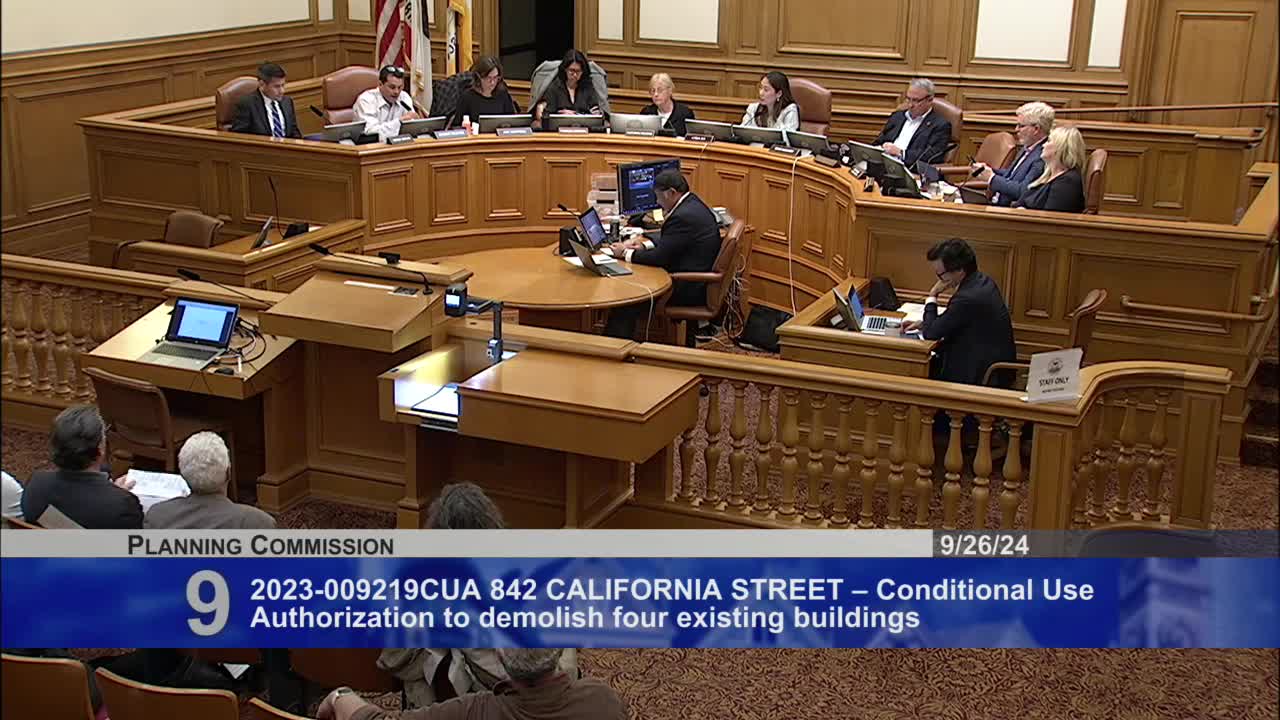Controversy erupts over demolition of rent controlled units
September 26, 2024 | San Francisco County, California
This article was created by AI summarizing key points discussed. AI makes mistakes, so for full details and context, please refer to the video of the full meeting. Please report any errors so we can fix them. Report an error »

In a recent government meeting, significant concerns were raised regarding the demolition of rent-controlled units in favor of new condominium developments. The discussion centered around a proposal to replace five rent-controlled units with three affordable condominiums, igniting a debate about housing needs and community character.
Commissioner Williams expressed apprehension about the loss of rent-controlled housing, emphasizing that many renters cannot afford to buy homes, even if the new units are labeled as affordable. He highlighted the historical significance of the existing buildings and their compatibility with the iconic California Street, arguing that the proposed development does not align with the neighborhood's character.
The planning staff clarified that the existing units have been vacant since 2020, following the sale of the property by its long-time owners. They explained that state law mandates the replacement of rent-controlled units with affordable ownership units in condominium developments, which has led to the current proposal. However, this has not alleviated concerns about the adequacy of affordable housing in the area.
Commissioner Imperial echoed these sentiments, questioning the demolition of a \"decent, safe building\" and the project's failure to honor the historical context of the site. He called for better tracking of tenancy history to ensure transparency in such decisions.
Despite the opposition, some commissioners, including Commissioner Campbell, supported the project, citing the urgent need for housing in the city. They noted that the proposal would increase the overall housing stock by 28 units, which is crucial given the city's ongoing housing crisis. The discussion also touched on the challenges of balancing state density bonus laws with local community needs.
As the meeting concluded, the commissioners faced a complex decision: weigh the immediate need for housing against the preservation of existing rent-controlled units and the character of the neighborhood. The outcome of this proposal could set a precedent for future developments in the city, highlighting the ongoing tension between housing development and community preservation.
Commissioner Williams expressed apprehension about the loss of rent-controlled housing, emphasizing that many renters cannot afford to buy homes, even if the new units are labeled as affordable. He highlighted the historical significance of the existing buildings and their compatibility with the iconic California Street, arguing that the proposed development does not align with the neighborhood's character.
The planning staff clarified that the existing units have been vacant since 2020, following the sale of the property by its long-time owners. They explained that state law mandates the replacement of rent-controlled units with affordable ownership units in condominium developments, which has led to the current proposal. However, this has not alleviated concerns about the adequacy of affordable housing in the area.
Commissioner Imperial echoed these sentiments, questioning the demolition of a \"decent, safe building\" and the project's failure to honor the historical context of the site. He called for better tracking of tenancy history to ensure transparency in such decisions.
Despite the opposition, some commissioners, including Commissioner Campbell, supported the project, citing the urgent need for housing in the city. They noted that the proposal would increase the overall housing stock by 28 units, which is crucial given the city's ongoing housing crisis. The discussion also touched on the challenges of balancing state density bonus laws with local community needs.
As the meeting concluded, the commissioners faced a complex decision: weigh the immediate need for housing against the preservation of existing rent-controlled units and the character of the neighborhood. The outcome of this proposal could set a precedent for future developments in the city, highlighting the ongoing tension between housing development and community preservation.
View full meeting
This article is based on a recent meeting—watch the full video and explore the complete transcript for deeper insights into the discussion.
View full meeting
